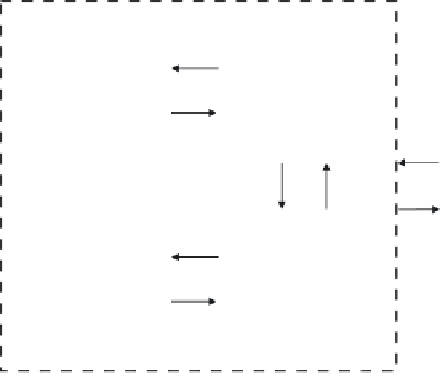Geoscience Reference
In-Depth Information
MICROSCALE AND
MESOSCALE
MACROSCALE
MEGASCALE
CLIMATE
HILLSLOPE
PROCESSES
HILLSLOPE
REGIME
Precipitation
Evapotranspiration
Variability
Talus production
Mass movement
Rilling
Mantled or unmantled
Faceted or nonfaceted
VALLEY
MORPHOLOGY
REGIONAL
DENUDATION
Valley cross-section
Network morphology
Drainage density
Drainage pattern
Valley head morphology
Active or relict
Water table
Hydraulic gradient
Regional incision
Recharge
CHANNEL
PROCESSES
HYDROLOGIC
REGIME
GEOLOGY
Pattern
Hydraulic geometry
Slope
Runoff
Sediment yield
Groundwater discharge
Permeability
Regional dip
Joints, faults
Tectonism
Figure 16.7
Factors influencing valley development by groundwater seepage erosion at a variety of scales (after Baker, 1990).
by seepage erosion does, however, appear to have inherent
thresholds, with different modes of operation under dif-
ferent lithological and climatic settings. Laity (in Baker,
1990) suggests that present-day groundwater discharge
and rates of cliff retreat in the Colorado Plateau may be
less than during previous wetter periods, implying that
a wetter climate will promote greater seepage erosion.
Conversely, Howard, Kochel and Holt (1988) hypothesise
that greater rainfall and groundwater outflow in this re-
gion would not increase erosion rates as it would hinder
the accumulation of minerals and hence salt weathering.
High rates of groundwater outflow do not, however, ap-
pear to be a hindrance to the development of seepage
erosion valleys in parts of the Hawaiian Islands (Kochel
and Piper, 1986) where chemical erosion and basal sap-
ping of basalts occurs around spring sites with consider-
ably higher discharges than those of the Colorado Plateau
(Laity and Malin, 1985; Kochel and Baker in Baker, 1990).
Clearly, further investigation of the variation in weather-
ing processes associated with ephemeral and perennial
groundwater seepage acting upon varying lithologies un-
der different climatic regimes is required.
ological faults and fractures may, for example, act as lin-
ear aquifers due to their enhanced permeability (Buckley
and Zeil, 1984), while igneous dykes may form barriers
to groundwater movement and compartmentalise aquifers
(Bromley
et al.
, 1994). In bedrock, subsurface flow will
be greatest along fractures and joint planes which are nor-
mal to the force equipotential surface of the regional water
table. Any leaching concentrated along these zones will
gradually lower valley bases (Newell, 1970; Buckley and
Zeil, 1984).
This process has been identified as a possible factor in
the formation of a number of valleys in dryland and sub-
humid regions, most notably in the development of some
African dambos (also termed
fadamas
,
vleis
,
bas-fonds
and
bolis
). Dambos are broad, shallow, seasonally wa-
terlogged, grassed depressions without a marked stream
channel, occupying valley floors, which commonly oc-
cur at the headwaters of stream networks (Mackel, 1974;
Acres
et al.
, 1985; Boast, 1990; Bullock, 1992). They are
found in areas with strongly seasonal rainfall regimes,
with present-day total annual precipitation in the range
600-1500 mm, and, like valleys attributed to formation by
seepage erosion processes, are not restricted to semi-arid
or dry subhumid environments. Climate does not appear
to be the overriding control upon the distribution of con-
temporary dambos, otherwise many hydrologically active
dambos would be relict features (Whitlow, 1985). Geol-
ogy and the influence of lithology upon soil characteristics
are important in determining drainage, while a flat, gentle
relief appears to be a prerequisite for formation (Mackel,
16.2.6
In situ deep-weathering and valley
development
A second method by which groundwater can contribute to
dryland valley formation is through the operation of deep-
weathering processes as groundwater moves vertically






